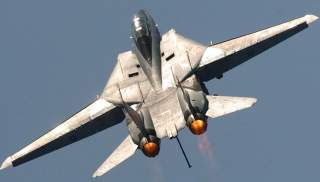Why Iran Loves America's Top Fighter Jet (Of the 1970s)
Tehran and the movie Top Gun share a strange connection.
In fact, several different “Super Tomcats” were proposed to the Navy that would have thoroughly modernized the aging avionics and made it fully capable as a multirole fighter. One variant, the Attack Super Tomcat 21, would even have featured an advanced AESA radar, vector-thrust engines (the engines nozzles could change pitch to improve maneuverability), and the ability to supercruise at Mach 1.2—that is, sustain flight speeds over the speed of sound without using the afterburner.
However, the Navy chose instead to field the F-18E/F Super Hornet. The Hornet airframe was not quite as optimized for air-to-air combat, but still delivered excellent performance, was based on fly-by-wire technology, and cost less money and time to fly and maintain. The choice between investing in a Super Tomcat or fielding the Super Hornet inevitably involved a trade-off, and the Super Hornet simply came out ahead in the Navy’s calculus.
Nonetheless, the Tomcat did prove itself to be one of the great American fighters of its era—in the hands of both the U.S. Navy and the Iranian Air Force.
Sébastien Roblin holds a Master’s Degree in Conflict Resolution from Georgetown University and served as a university instructor for the Peace Corps in China. He has also worked in education, editing, and refugee resettlement in France and the United States. He currently writes on security and military history for War Is Boring.
This first appeared in October 2016.

